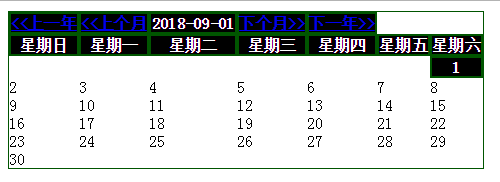溫馨提示×
您好,登錄后才能下訂單哦!
點擊 登錄注冊 即表示同意《億速云用戶服務條款》
您好,登錄后才能下訂單哦!
這篇文章將為大家詳細講解有關怎么在PHP項目中實現一個日歷功能,文章內容質量較高,因此小編分享給大家做個參考,希望大家閱讀完這篇文章后對相關知識有一定的了解。
具體如下:
<?php
header("Content-Type:text/html;charset=utf-8");
date_default_timezone_set("PRC");
$a=@$_GET["a"];
$b=@$_GET["b"];
if($a){
$a=$a;
}else{
$a=date('y');
}
if($b){
$b=$b;
}else{
$b=date('m');
}
$noe=mktime(0,0,0,$b,1,$a); //獲取當前的月的一號
$year=date("Y",$noe); //當前的年
$month=date("m",$noe); //當前的月
$week=date("w",$noe); // 每個月的一號是星期幾
$days=date("t",$noe); //每個月的總天數
$day=date("d"); //獲取今天是幾號
$as=$year-1; //獲取上一年的年
$bs=$month-1; //獲取上個月
$bs=$month+1; // 獲取下個月
$as=$year+1; //獲取下一年
?>
<!doctype html>
<html lang="en">
<head>
<meta charset="UTF-8">
<title>日歷</title>
<style>
table{
border: 1px solid #050;
}
table th{
background:#000;
color:#fff;
border: 2px solid #050;
}
</style>
</head>
<body>
<table cellpadding="0" cellspacing="0">
<tr>
<th><a href="?a=<?php echo $as; ?>" rel="external nofollow" rel="external nofollow" ><<上一年</a></th>
<th><a href="?b=<?php echo $bs; ?>" rel="external nofollow" rel="external nofollow" ><<上個月</a></th>
<th><?php echo $year."-".$month."-".$day ?></th>
<th><a href="?b=<?php echo $bs; ?>" rel="external nofollow" rel="external nofollow" >下個月>></a></th>
<th><a href="?a=<?php echo $as; ?>" rel="external nofollow" rel="external nofollow" >下一年>></a></th>
</tr>
<tr>
<th>星期日</th>
<th>星期一</th>
<th>星期二</th>
<th>星期三</th>
<th>星期四</th>
<th>星期五</th>
<th>星期六</th>
</tr>
<tr>
<?php
for($i=0;$i<$week;$i++){
echo "<td> </td>"; //獲取當月一號前面的空格
}
for($k=1;$k<=$days;$k++){
if($k==$day){
echo "<th>".$k."</th>"; //輸出今天是幾號
}else{
echo "<td>".$k."</td>"; //輸出當月天數
}
if(($k+$week)%7==0){
echo "<tr></tr>"; // 一周七天換行
}
}
?>
</tr>
</table>
</body>
</html>運行結果:

關于怎么在PHP項目中實現一個日歷功能就分享到這里了,希望以上內容可以對大家有一定的幫助,可以學到更多知識。如果覺得文章不錯,可以把它分享出去讓更多的人看到。
免責聲明:本站發布的內容(圖片、視頻和文字)以原創、轉載和分享為主,文章觀點不代表本網站立場,如果涉及侵權請聯系站長郵箱:is@yisu.com進行舉報,并提供相關證據,一經查實,將立刻刪除涉嫌侵權內容。